Welcome, fellow feline fanciers, to the mystical and complicated world of cat litter boxes! If you’ve ever found yourself pondering the mysteries of litter box etiquette or seeking answers to burning litter-related questions, you’ve come to the right place. In this article, we’ll embark on an informative journey through the litter box realm, exploring the curious queries that every cat parent has on their mind.
From the ideal litter box placement to the secrets of litter box training, we’ll tackle these topics and more. So grab your catnip tea, find a cozy spot, and dive into the captivating world of litter box inquiries that will leave you purring with knowledge! And let’s start with why cats are instinctually drawn to litter boxes.
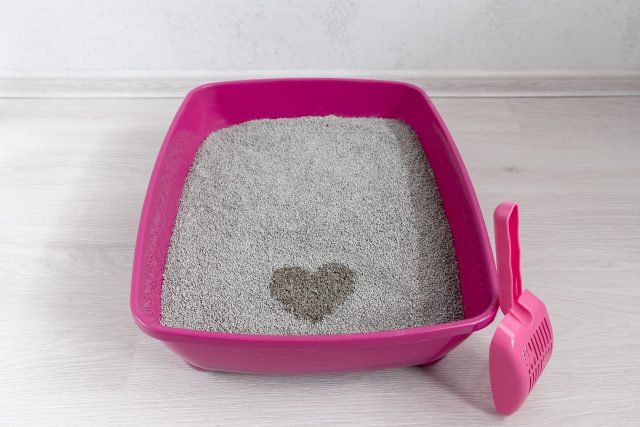
Cat Litter Boxes: Your Questions Answered
#1 – Why are cats drawn to litter boxes?
Cats are naturally drawn to litter boxes for several reasons:
- Instinctual Behavior: Cats have an innate instinct to bury their waste. In the wild, this behavior helps them to avoid attracting predators by covering their scent. Litter boxes simulate the natural environment where cats can dig and bury their waste.
- Scent Marking: Cats have scent glands in their paws, and when they scratch the litter in the box, they mark their territory. This behavior helps them feel secure in their environment and establish their presence.
- Hygiene and Cleanliness: Cats are generally clean animals, and using a litter box helps them maintain their personal hygiene. They prefer a designated area for eliminating waste rather than soiling other parts of the house.
- Comfort and Privacy: Litter boxes provide cats with a secluded and private space to do their business. Cats appreciate having a quiet and undisturbed area where they can feel safe and secure.
- Familiarity and Routine: Once cats are introduced to using a litter box during their kittenhood, they become accustomed to it. The familiar smell and texture of the litter help cats associate the box with their toileting routine.
It’s important to note that if a cat suddenly starts avoiding the litter box or shows changes in behavior, it could indicate a health issue or other problem. In such cases, consulting a veterinarian is recommended to identify and address the underlying cause.
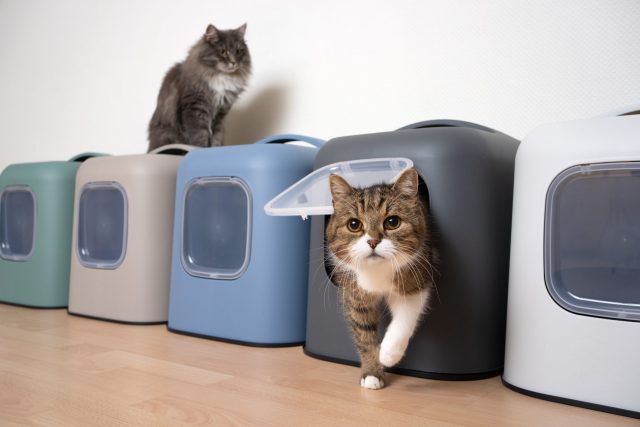
General Litter Box Questions
What types of litter boxes are there?
Prepare to discover a variety of litter box designs fit for the feline royalty in your life. Here are some enchanting options:
The Classic Kitty Pan
Behold the timeless treasure, the traditional open-top plastic or stainless steel litter box in plastic or stainless steel. Cats can prance in with confidence and take care of their royal business in a box that’s open and allows plenty of room to move. Simple, reliable, and fit for a regal cat!
The Robo-Restroom
Prepare to be amazed by the automatic litter box, where technology and convenience unite! These futuristic marvels use sensors, timers, and clever mechanisms to automatically sift, rake, or remove waste from the litter box. It’s like having a robotic butler that attends to your cat’s litter needs, leaving you more time for play and cuddles. Sit back, relax, and let the robo-restroom take care of the dirty work!
RELATED: 8 Best Self Cleaning Litter Boxes for Cats [2023]
The Hidden Haven
For those who crave elegance and a touch of mystery, there’s the hidden litter box. Disguised as a piece of furniture or cleverly concealed within a nook, litter box furniture adds a touch of sophistication to your home while keeping the litter box out of sight. Your guests will never suspect the secret it holds!
The Cozy Corner
Cats love their privacy, so the covered litter box is like a private den just for them. It’s their own little retreat, shielding their majestic presence from prying eyes. Plus, the cover helps contain litter-flinging escapades, keeping your floors tidier and your cat feeling like a true VIP.
The Sifting Sorcery
Sifting litter boxes is an ingenious idea with a built-in sifting mechanism that allows you to separate the clumps from the clean litter effortlessly. It’s like having a wizard’s wand that banishes the soiled bits, leaving only pristine litter behind. No more scooping woes or messy hands!
The Disposable Delight
For the ultimate in convenience, behold the disposable litter box! It’s a ready-to-use box made of sturdy materials that you can simply discard when it’s time for a fresh start. Perfect for travel or temporary situations, these boxes make life a breeze—no scrubbing, no fuss. Just unwrap, let your cat work their magic, and bid farewell to the litter box when its time has come.
Remember, each cat has their own preferences, so finding the perfect litter box fit may involve a bit of experimentation. Pay attention to your cat’s habits and quirks, and let their personality guide you toward their litter box utopia.
RELATED: The 11 Best Cat Litter Boxes For The Purrfect Potty Experience
#2 – Where should I place my cat’s litter box?
Above all else, you want to choose a location that offers a good balance of convenience for your cat and practicality for you. Here are a few pointers:
- The Purrivate Powder Room: Cats appreciate privacy just like we do! Find a quiet, low-traffic area where your kitty can do their business without feeling watched or interrupted. Think of it as their exclusive spa retreat for bathroom breaks!
- Avoid Traffic: Nobody likes traffic jams, not even your cat! Keep the litter box away from noisy appliances, crowded hallways, or high-traffic areas. Cats prefer a serene atmosphere where they can focus on their important “business” meetings undisturbed.
- Accessibility: Consider your cat’s agility and accessibility needs. If you have a senior cat or a kitten, make sure the litter box is easily reachable without any difficult jumps or obstacles.
- Room with a View: Well, maybe not an actual view, but a strategic placement near a window can add a touch of excitement to the litter box experience. Cats often appreciate a glimpse of the outside world while taking care of business, as it keeps them entertained and in touch with their wild instincts.
- “Smellcome” to Odor Control: Place the litter box in a well-ventilated area, preferably with good air circulation. This helps keep the air fresh and the litter box area smelling less, well, “catty.”
Remember, each cat has their own preferences, so it might take a bit of trial and error to discover the ideal spot. Observe your kitty’s behavior and adjust accordingly. With a little creativity and a touch of feline finesse, you’ll find the purrfect spot for your cat’s litter box.
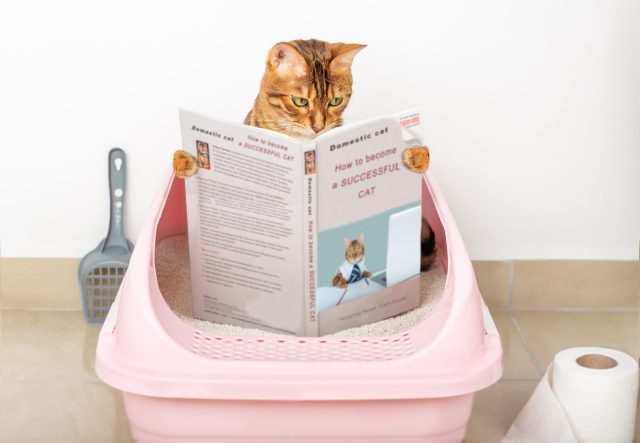
#3 – Do senior cats need a different type of litter box?
Our wise and distinguished senior cats deserve the utmost comfort in their litter box endeavors! And a senior cat litter box features lower entry points, allowing our elderly feline friends to step in without any acrobatics gracefully. The senior cat litter box understands that jumping and climbing might not be as easy as it once was, providing easier access to a litter paradise via a low threshold or lower sides.
#4 – What type of litter is best for my cat?
Let’s explore the exciting world of litter options, shall we? Here are some pointers to help you find the best fit for your furry friend:
- The Clawsome Clumping Champions: Clumping litters are like superheroes in the litter universe! They form neat clumps when your kitty does their duty, making scooping a breeze. It’s like having a litter genie that grants your wish for easy cleanup!
- Silica Gel: The “Crystal Connoisseur”: For those who seek litter sophistication, behold the wonders of silica gel! Silica gel litter is made up of absorbent crystals that work like tiny superheroes, trapping moisture and locking away odors. It’s like having a luxurious spa retreat for your cat’s bathroom endeavors!
- Scent-sational or Scent-Free? Some cats prefer a litter that smells like a field of flowers, while others turn their noses up at any fragrance. It’s a matter of personal preference, really. If your cat enjoys the fragrant life, go for scented litter. If they’re more of a purist, opt for unscented varieties to let their natural essence shine.
- Soft Paws and Gentle Toes: Some cats are a bit diva-ish about their delicate paws. If your feline friend is particularly sensitive, look for a litter with a finer texture. It’ll be as soft as a cloud under their precious toes, providing the utmost comfort for their royal bathroom experience.
- Eco-Champs: For the environmentally conscious cat parents, eco-friendly litters, like corn, wheat, soy, and wood, or those made from recycled materials, like newspaper, are a fantastic choice. They’re like a green hug for the planet! On the other paw, crystal litters offer excellent odor control and absorbency, keeping your home fresh and fancy.
- Dust Be Gone! Nobody wants a dusty cloud floating around the litter box area. So, opt for low-dust litters to ensure you and your cat can breathe easily.
Remember, your cat may have their preferences, so it’s a good idea to introduce new litter gradually. Mix a bit of the new litter with their existing one to ease them into the transition. And hey, if your kitty happily hops into the litter box and emerges with a contented purr, you’ve found the litter jackpot! Happy litter hunting!
RELATED: 9 Best Cat Litter Products Of 2023
#5 – How much litter should I use in the pan?
When filling your cat’s litter pan, aim for around 2-3 inches (5-7.5 cm) of litter, creating a comfortable depth for digging and burying waste. Avoid overfilling, as it can lead to litter flying out or overwhelming your cat. With clumping litter, ensure there’s enough for proper clump formation, making scooping a breeze. Remember to periodically add more litter to maintain a sufficient level and provide a fresh spot for your cat’s bathroom needs. Ultimately, finding the right litter depth is about striking a balance between your cat’s preferences and practicality.
#6 – How many litter boxes per cat?
Let’s dive into the magical world of litter box math, shall we? As a general rule of paw, it’s ideal to have one litter box per cat, plus an extra “bonus” box. Think of it as the VIP lounge for their bathroom adventures! Cats appreciate having options and a little extra wiggle room to do their business without feeling crowded. Plus, it helps prevent any potential feline feuds over territory. So, go ahead and set up a litter box wonderland, a kitty potty paradise where each cat can have their own designated spot to do their thing. Everyone will thank you with happy purrs!
#7 – Can I use a litter box liner?
Certainly! Litter box liners can be a helpful option for easier cleanup if you prefer a tidier experience. They act as a protective layer inside the litter box, making scooping more convenient. However, it’s important to consider your cat’s preferences and behavior. Some cats may enjoy playing with or scratching the liner, which could lead to some unraveled fun. So, it’s worth observing how your furry friend reacts to the liner. If they’re comfortable with it, then go ahead and let the liner add a touch of practicality to their litter box routine.
#8 – How can I keep my dog from getting into the cat’s litter box?
Ah, the legendary tale of the litter box heist! Fear not, for these tips can help thwart your mischievous pup’s litter box endeavors:
- The Fort Knox of Litter: Transform the litter box area into an impenetrable fortress of feline secrecy. Consider using a litter box with a top-entry design, like a secret vault accessible only to your nimble cat. Its elevated entrance will confound your dog, leaving them scratching their furry head in bewilderment.
- The Furniture Fortress: Cat litter box furniture can also confound your pup and provide your cat with a private retreat. These marvelous creations are disguised as stylish pieces of furniture, such as cabinets or benches, hiding the litter box within their elegant façade. It’s like a magical transformation, turning a mundane necessity into a chic addition to your home decor.
- The Doggy Distraction: Engage your pup’s senses and divert their attention away from the forbidden litter box. Create a delightful doggy distraction zone filled with interactive toys, tasty treats, and puzzle games. It’s like a treasure trove of doggy delights that keeps their inquisitive mind and paws occupied elsewhere.
Remember, consistency is key! Reward your dog for good behavior and gently discourage any attempts to infiltrate the litter box area. Let your cat’s litter box remain a sacred sanctuary while your dog embarks on adventures of their own.
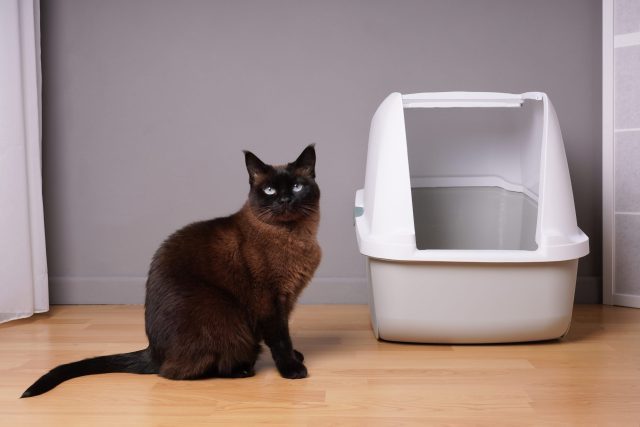
Behavioral Questions About Litter Boxes and Cats
#9 – How do I train my cat to use the litter box?
Cats are usually quick to learn how to use the litter pan, and these tips can help the process along nicely:
- Location, Location, Location: Find the ideal spot for your cat’s litter box. Choose a quiet, easily accessible area that offers them privacy and serenity. Introduce them to the litter box oasis like a grand tour guide, showcasing its wonders with a positive vibe.
- Kitty 101: Litter Box Basics: Gently place your cat in the litter box a few times. They may paw around, investigating this new domain and the litter beneath their toes. Celebrate their litter box exploration with praise and encouraging words. It’s like cheering on a furry archaeologist!
- Digs and Deposits: Watch for signs your cat needs to go, such as scratching or sniffing around. When you see these cues, gently place them in the litter box. Encourage them to dig in the litter and praise them for any deposits made.
- Potty Pawsitivty: Positive reinforcement helps cats associate the litter box with pleasant experiences, so celebrate every successful litter box visit with treats, pets, and joyful exclamations. It’s like throwing a grand party for your cat’s bathroom triumphs!
- Consistency and Cleanliness: Keep the litter box clean and fresh, scooping it regularly and changing the litter as needed. Cats appreciate a pristine throne, so cleanliness is the key to litter box loyalty.
- Litter Magic: Experiment with different litter types to find the one that tickles your cat’s fancy. Some prefer clumping litter, while others prefer non-clumping or natural alternatives. Let their paw-ticipation guide you to their preferred litter treasure.
Remember, every cat is unique, and patience is your secret weapon. With time and encouragement, your cat will become a litter box aficionado. So, embark on this journey with a sense of adventure, and celebrate each successful litter box conquest with joyous purrs and triumphant meows!
#10 – Why is my cat pooping outside the litter box?
Here are some possible clues to consider when figuring out the mystery behind your cat pooping outside the litter box:
- Litter Box Detective Work: First, examine the litter box itself. Is it clean and inviting? Cats have high standards, and a dirty litter box may discourage them from using it. Ensure you scoop regularly and change the litter as needed. A fresh and appealing litter box is a feline magnet!
- Location Dud?: Is the litter box conveniently located? Cats value privacy and tranquility, so placing the litter box in a peaceful, low-traffic area can help them feel more at ease. Additionally, consider if there have been any recent changes in the household that might be causing stress.
- Litter Preferences: Cats can be picky about litter. If you’ve recently changed the litter brand or type, your cat may express their displeasure by going elsewhere. Try experimenting with different litters to find one that aligns with your cat’s preferences.
- Health Matters: Sometimes, pooping outside the litter box can be a sign of an underlying health issue. If you’ve ruled out environmental factors and litter concerns, it’s best to consult a veterinarian. They can examine your cat for any medical conditions that may be causing the behavior.
- Stress and Anxiety: Cats are sensitive creatures, and changes in their environment or routine can trigger stress. This stress may manifest as litter box avoidance. Evaluate if there have been any recent changes, such as new pets, renovations, or disruptions that might be causing anxiety for your cat.
Remember, each cat is unique, and this mystery may require some sleuthing to solve. Stay patient, observe your cat’s behavior, and make adjustments accordingly. With a little detective work and a sprinkle of love, you’ll help your feline friend find their litter box bliss once again!
#11 – Why is my cat peeing outside the litter box?
So, the answer as to why cats pee outside the litter box typically follows the same reasoning for pooping out the pan. Litter dislike, stress, location, and health issues like urinary tract infections, kidney problems, or bladder concerns might be the sneaky culprits. Solving this all-too-common cat concern may take time and patience. Stay vigilant, provide a clean and comfortable litter box, consider your cat’s preferences, and seek veterinary advice. If your cat is a senior, urinating outside the box may also indicate a mobility issue. Consider changing to a low-sided litter box and placing it somewhere easy to access and close to your cat’s favorite resting spots.
#12 – How do I introduce a new litter box to my cat?
The grand unveiling of a new litter box! Let’s make it an event fit for feline royalty, filled with intrigue and excitement. Here’s a guide to new pan success:
- The Unboxing Ceremony: Treat the new litter box like a treasure chest of surprises. Place it in a quiet, accessible area and remove any packaging. Invite your curious cat to witness the grand reveal. It’s like a kitty red carpet event!
- The Scent of Familiarity: Cats rely heavily on their sense of smell. To make the new litter box more inviting, sprinkle a bit of the old litter from their existing box onto the fresh litter in the new box. This mingling of scents will create a bridge of familiarity, like a scent-based handshake.
- Pawsitive Exploration: Encourage your cat to explore the new litter box at their own pace. Allow them to sniff, paw, and investigate this novel addition to their domain. Shower them with praise and treats for their adventurous spirit.
- Gradual Transition: If you’re replacing an old litter box, provide both the old and new options side by side for a brief transition period. This allows your cat to adjust gradually, ensuring a smooth, stress-free shift.
- Praise and Rewards: Celebrate every successful litter box visit with lavish praise, pets, and perhaps a tasty treat or two. Positive reinforcement creates a positive association with the new litter box, like a victory dance party for every litter box triumph!
Remember, patience and encouragement are key. Each cat is unique, so the adjustment period may vary.

#13 – My cat is eating litter. Is this normal, or should I be concerned?
While it may seem curious, eating litter is not considered normal behavior for cats. Ingesting litter can pose potential risks to their digestive system, so it’s best to be cautious. Consider switching to a different litter type and provide engaging toys and distractions to redirect their focus. If the behavior persists or causes distress, consult a veterinarian for guidance.
#14 – How do I stop my cat from eating litter?
Guide your cat away from their litter-feasting adventures with these tips:
- Litter Switch-Up: Start by changing to a different litter type. Opt for non-clay, natural, or paper-based alternatives that are less tempting for your curious kitty’s palate.
- Litter Tastes Bad, Yuck!: Make the litter unappetizing by using a taste deterrent spray available at pet stores. These sprays are designed to deter cats from nibbling on undesirable objects. A little spritz of “yuckiness” can help redirect their interest to more suitable snacks.
- Distraction Tactics: Provide plenty of engaging toys, puzzle feeders, and interactive play sessions to keep your cat’s mind and paws occupied elsewhere. A stimulated cat is less likely to seek out alternative sources of entertainment, like munching on litter.
- Seek Veterinary Advice: If your cat’s litter-eating habit persists or causes concern, consult your veterinarian. They can assess your cat’s health and provide specific recommendations tailored to your feline friend’s needs.
Remember, patience and consistency are key when addressing unwanted behaviors. By implementing these strategies and monitoring your cat closely, you’ll help steer them away from the litter buffet and towards safer, more suitable activities.
#15 – Why is my cat lying in the litter box?
While it may seem like an unusual choice for relaxation, there can be several reasons why your cat is taking up residence in the litter box:
- Seeking Comfort: Cats often look for cozy and secure spots, and the litter box may provide a sense of security. It’s like their own little nook, a place where they feel safe and undisturbed. However, this behavior can indicate a deeper need for comfort and reassurance.
- Stress Relief Sanctuary: Cats may retreat to the litter box if they’re feeling stressed or anxious. It offers a small, enclosed space where they can retreat from the world. If your cat is going through changes or if there have been disruptions in the household, they may seek solace in the litter box.
- Investigating Health Concerns: Occasionally, cats may lay in the litter box due to underlying health issues. Pain or discomfort in certain areas of their body may lead them to seek the litter box as a place of relief. If you notice any other unusual signs or if this behavior persists, it’s wise to consult a veterinarian.
- Environmental Enrichment: Ensure your cat has other cozy spots and designated resting areas throughout the house. Provide soft bedding, warm blankets, or cat beds to give them alternative options for relaxation. Creating a stimulating and comfortable environment can help divert their attention from the litter box.
Remember, each cat is unique, and understanding their individual needs is crucial. Observe their behavior, provide alternative cozy spaces, and monitor their overall health and well-being. If you’re concerned or the behavior continues, it’s always a good idea to seek professional advice.

Litter Box Cleaning Questions
#16 – What’s the best way to clean a litter box?
Cleaning the litter box is a necessary chore in the realm of feline guardianship, and here’s how you can best maintain a fresh and hygienic litter box environment:
- Scoop, Scoop, Scoop: Regular scooping is the key to a clean litter box. Ideally, scoop out solid waste and clumps of urine-soaked litter at least once a day. For multiple cat households, twice daily scooping may be needed. A sturdy litter scoop will be your trusty ally in this endeavor. Poop bags or litter waste disposal systems can help with scoop duty.
- Freshen Up the Box: After scooping, replenish the litter box with fresh litter as needed. Maintaining an appropriate litter depth of around 2-3 inches is recommended. Top up with new litter to provide a pleasant digging experience for your feline friend.
- Thorough Cleaning Sessions: Give the litter box a more thorough cleaning every few weeks. Empty the entire contents of the box and scrub it with mild, unscented soap and warm water. Rinse thoroughly to remove any soap residue. Allow the box to air-dry completely before adding fresh litter.
- Odor Control Arsenal: To combat any lingering odors, consider using litter box deodorizers or baking soda sprinkled at the bottom of the box before adding fresh litter. These odor-absorbing agents can help keep your home smelling fresh and pleasant.
- Box Replacement: Over time, litter boxes may show signs of wear and tear. If your litter box becomes cracked or difficult to clean, it’s advisable to replace it. Opt for a new litter box that suits your cat’s size and provides enough space for them to maneuver comfortably.
Remember, cleanliness is crucial to your cat’s well-being and litter box acceptance. Diligently following these cleaning practices ensures your cat has a purrfectly clean and inviting litter box experience every time they step into their private bathroom haven.
#17 – What can I clean my cat’s litter box with?
Clean your cat’s litter box with mild, unscented dish soap and warm water. Avoid harsh chemicals, strong detergents, or scented cleaners, as they may leave behind residues that could be off-putting to your cat. Remember to rinse the box thoroughly to remove any soap residue before adding fresh litter.
#18 – Can you clean a litter box with Clorox wipes or other wipes?
It’s best to avoid using Clorox wipes or other disinfectant wipes directly on the litter box. These wipes often contain chemicals that can leave residues and strong odors that might deter your cat from using the box. Stick to using mild soap and water for cleaning the litter box.
#19 – Can I Lysol my cat’s litter box?
Using Lysol or other similar disinfectants directly on the litter box is not recommended. These products may contain harsh chemicals that can harm your cat if ingested.
#20 – Is bleach safe to use on the litter box?
While bleach can effectively kill germs, it’s best to avoid using it in the litter box. The strong scent and residue left by bleach may discourage your cat from using the box. If you need to disinfect the litter box, consider using a pet-safe, non-toxic cleaner specifically formulated for cat litter boxes.
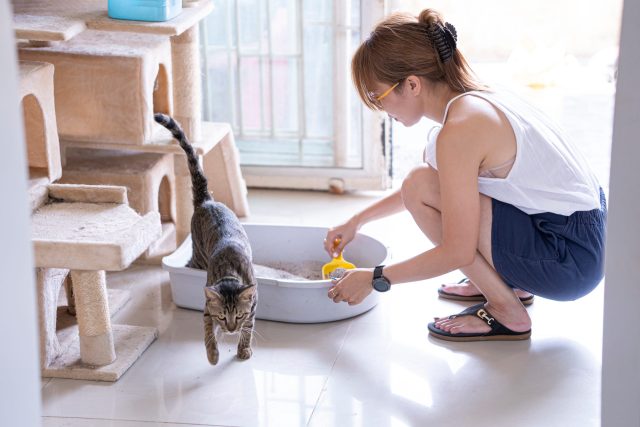
#21 – How often should I clean my cat’s litter box?
Scooping the litter box daily is recommended to remove solid waste and clumps. In a home with multiple cats, consider scooping twice a day. Additionally, a more thorough cleaning should be done every few weeks.
#22 – How often should a litter box be replaced?
The frequency of replacing a litter box depends on several factors, including the type of litter box, its condition, and your cat’s habits. Generally, a litter box can last for several years with proper care. However, there are a few instances where replacing the litter box is recommended:
- Wear and Tear: If the litter box shows signs of significant wear, such as cracks, breakage, or damage that compromises its structural integrity, it’s time for a replacement. A damaged box may be harder to clean or may retain odors more easily.
- Difficult to Clean: Despite your best efforts, it may be time for an upgrade if your current litter box is challenging to clean. A litter box with grooves from repeated scratching can be difficult to clean, leading to hygiene issues and unpleasant odors.
- Size or Comfort: Consider your cat’s size and comfort. If your cat has outgrown the litter box or seems cramped inside it, providing a larger litter box can improve their comfort and encourage proper use. If your cat has aged, consider a litter box with low sides or a lower entry threshold.
- Behavioral Issues: If your cat has developed litter box aversion or consistently avoids using the litter box despite efforts to address the issue, introducing a new litter box with a different design or location might help resolve the problem.
Remember, cats appreciate a clean and comfortable bathroom experience. Regular cleaning, proper maintenance, and observing your cat’s needs will help determine if and when a litter box replacement is necessary.
#23 – How can I prevent litter box odor?
To prevent litter box odor, maintain a consistent scooping routine to remove waste promptly. Consider using odor-controlling litter or adding baking soda to absorb odors. Ensure the litter box is adequately ventilated, and consider placing an air purifier nearby to help neutralize any remaining odors.
RELATED: The 8 Best Air Purifiers For Pets
#24 – My cat is tracking litter everywhere. How can I reduce this?
To minimize litter tracking, use a litter mat or rug outside the litter box to capture stray litter particles. Opt for larger, heavier litter granules that are less likely to stick to your cat’s paws. Additionally, you can try placing the litter box on a raised surface or using a litter box with higher sides to minimize tracking.
RELATED: The 5 Best Cat Litter Mat Choices To Reduce Litter Tracking
#25 – How often should I completely change the litter in the box?
The frequency of completely changing the litter depends on the type of litter you use, the number of cats, and your cat’s preferences. As a general guideline, it’s recommended to completely change the litter and clean the box every two to four weeks. However, if you notice strong odors or the litter is heavily soiled, it’s best to change it more frequently to maintain a clean and fresh environment for your cat.
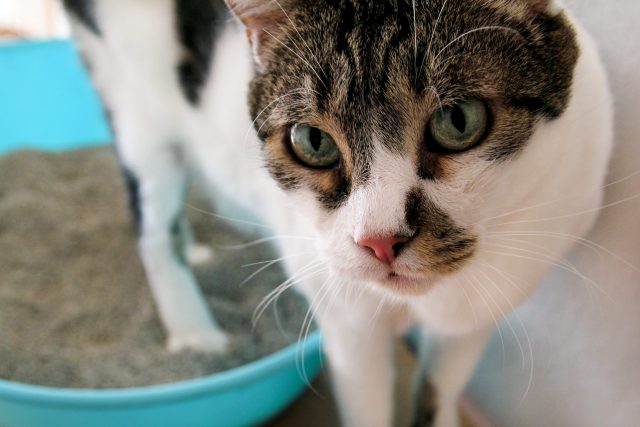
So, there are certainly more litter box questions out there than these because cats are quite talented at vexing their families! But these twenty-five questions and answers about your cat’s litter box should provide you with a pretty good insight into how your kitty thinks about their pan. So, go forth, cat minion, and clean your kitty majesty’s potty throne.

